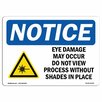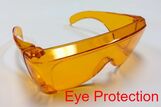|
Formula
Procedure of Application
Development Complete When
Source of Error
Incompatibilities
Precautions
Storage Container
Safety
Recommendations
Similar Reagent
Sequential Reagent
Formula
Used for:
Centered Wavelengths: A. 300 nm to 400 nm Fluorescing U-V sensitive powders or dyes. Fluorescing physiological fluids. Ardrox excitation. B. 400 nm to 450 nm R.A.Y. excitation. Absorbing blood\bite mark detail. Fluorescing physiological fluids. C. 455 nm to 515 nm Searching on non-fluorescent backgrounds. Basic Yellow 40 excitation. Zinc chloride excitation. D. 550 nm to 590 nm Searching on highly fluorescent backgrounds. DFO excitation. Procedure of Application
Development Complete When
All the item's surfaces have been examined. Source of Error
Handing items (by handles) in their normal manner may obliterate or smudge visible detail. Incompatibilities
Items that inherently luminescence in the may quench any fluorescence of the ridge detail. Precautions
Ascertain that items do not have liquid or loose components that may spill if the item is subjected to maneuvering. Storage Container
Not applicable. Safety
Ultra-violet light absorbing protective eyewear must be worn at wavelengths around 350 nm to 415 nm. Recommendations
Adjusting and tuning the excitation wavelength, along with proper selection of barrier filter, may produce better visualization results. Similar Reagent
Sequential Reagent
Not Necessarily in this Order: Vertical Divider
|
Chemical Name
Fluorescence Examination Surface Used On Non-Destructive for all surfaces Sensitive To Absorption/Emittence of various light wavelengths Vertical Divider
|
Ridge Detail Visualized by:
Forensic Light Source induced Reagent Applicabilities: Porous Surfaces Non-Porous Surfaces Non-Destructive Other Chemical Name(s): Alternate Light Source Forensic Light Source Laser |
Process Summary:
A non-destructive technique to note the presence of visible detail. Several models of Forensic Light Sources are available, most of which provide an excitation wavelength range from 350 nm to 600 nm. Improved viewing of the ridge detail is accomplished either by rendering the ridge detail darker upon viewing in an absorption mode, or, through fluorescence of the ridge detail which is either rendered luminescent when exposed to the light, or made fluorescent by the addition of chemicals. Orange, Red or Yellow viewing barrier filters (viewing goggles) are used for viewing or during photography of the detail. The goal of Fluorescent examinations is to achieve the maximum fluorescence of the ridge detail with the minimum of background fluorescence/reflection.
A non-destructive technique to note the presence of visible detail. Several models of Forensic Light Sources are available, most of which provide an excitation wavelength range from 350 nm to 600 nm. Improved viewing of the ridge detail is accomplished either by rendering the ridge detail darker upon viewing in an absorption mode, or, through fluorescence of the ridge detail which is either rendered luminescent when exposed to the light, or made fluorescent by the addition of chemicals. Orange, Red or Yellow viewing barrier filters (viewing goggles) are used for viewing or during photography of the detail. The goal of Fluorescent examinations is to achieve the maximum fluorescence of the ridge detail with the minimum of background fluorescence/reflection.
Accepted Deviations:
Adjusting the wavelength of the light source may produce better visualization results. Different manufacturers produce products that provide excitation wavelengths at different pre-selected wavelengths, and over different wavelength range.
Adjusting the wavelength of the light source may produce better visualization results. Different manufacturers produce products that provide excitation wavelengths at different pre-selected wavelengths, and over different wavelength range.
Supporting Reference Materials:
- Advances in Fingeprint Technology 2nd. Ed., Lee, H.C. & Gaensslen, R.E., CRC Press, Boca Raton, FL., 2001.
- Manual of Fingerprint Development Techniques 2nd. Ed., Home Office - Police Scientific Development Branch, White Crescent Press, Ltd., Luton, England, 2001.




